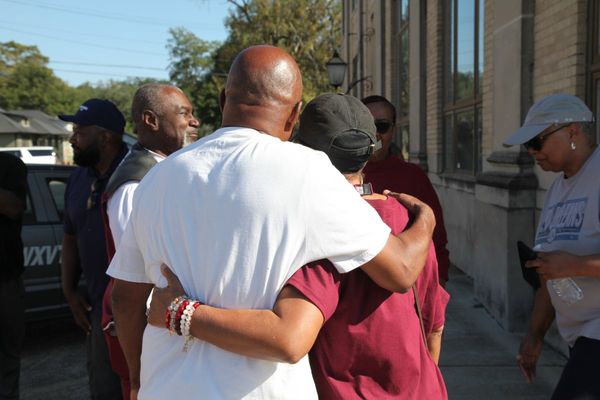The delivery drivers of the future may not leave a package at your door. Instead, they'll be sitting several miles or even time zones away in a control room overseeing a fleet of delivery robots or drones.

Companies are plowing billions of dollars into autonomous technologies they hope will improve efficiency and solve worker shortages. But executives in these industries say true autonomy is many years away -- and may never come. So they are striving to dramatically ramp up the number of machines each human oversees.
Food-deliverer Serve Robotics Inc., for instance, now has one supervisor in a control room for every four robots on the street.
"Eventually, you are going to see a ratio of one person for hundreds, maybe more, robots, given enough time," says Ali Kashani, the company's co-founder and chief executive.
Achieving this means helping machines better deal with an array of hurdles they face trying to operate in a human world.
Delivery robots navigate complex sidewalks where obstructions such as rideshare scooters and trash shift from hour to hour. Self-driving cars and trucks are helped by infrastructure like road markings and traffic signals that guide their way -- but they can be bamboozled by unusual situations like having to cross a double yellow line because of road work. That's when humans have to step in and tell the machine what to do, or take it over with remote control.
Forklifts are among the vehicles at the cutting edge of remote-control advances, as technology increasingly allows drivers to operate them from hundreds of miles away.
Software developer Phantom Auto Inc. recently raised $42 million in a funding round led by trucking company ArcBest Corp. and logistics provider NFI Industries Inc.
The two companies, which plan to deploy thousands of remote-controlled forklifts at their warehouses, hope the technology will allow them to draw on a wider pool of skilled drivers instead of being limited to workers within commuting distance of warehouses.
"Autonomy has limitations," says Elliot Katz, a co-founder of Phantom Auto, "especially when you're in a highly dynamic environment like a warehouse where you have humans and vehicles moving around at a fast pace and stuff on the ground."
Today, Phantom Auto's remote operators take control of a forklift truck for all of its operations. But soon semi-autonomous forklift trucks will run on their own for mundane tasks like moving from one end of a warehouse to another, Mr. Katz says.
"By 2030 you're going to have human operators doing the complex work, such as loading or unloading a trailer, placing pallets in variable racking heights. But for the less-complex elements you're going to have technology taking over," he says. "So it's going to be humans working hand-in-hand with autonomy, and that is how unmanned vehicles are really going to actually deploy."
Some long-distance trucking technology companies say remote control of trucks on public roads isn't safe because it relies on wireless signals that could be interrupted. Instead, they are pinning their hopes on autonomous technology to drive the truck, paired with human supervisors who step in remotely to provide direction when the truck needs to make an unexpected decision, such as whether it should cross onto a shoulder to go around a broken-down car.
"It's going to be experienced drivers who know how trucks work and are able to play a part in helping our system function," says Rocky Garff, head of trucking operations for Waymo, the Mountain View, California-based autonomous-vehicle company and subsidiary of Google parent Alphabet Inc.
Waymo's autonomous software and hardware run today in trucks that have an "autonomous specialist" in the driver's seat.
Mr. Garff says long-distance trucks could be running without people in the cab in a couple of years -- but most likely only on the highway. A human driver will need to get into the truck to take it from the highway to a warehouse.
Gatik AI Inc., an autonomous trucking company that specializes in shorter-distance freight trips using lighter box trucks, is already operating end-to-end trips without drivers.
The company carries Walmart loads between a distribution center and a retail store along a 7.1-mile route in Bentonville, Arkansas.
Remote supervisors step in when the company's trucks encounter unanticipated obstacles, such as a fallen tree blocking a road or a lane closure that requires the truck to cross double yellow lines, says Gautam Narang, Gatik's co-founder and chief executive.
When the service launched in 2019 with one supervisor per truck, the supervisors assisted each vehicle once or twice per trip, he says.
Today, Gatik's supervisors step in just once or twice per week.
The company plans to increase its ratio to five trucks per supervisor next year. In five to seven years, a single Gatik supervisor could oversee 40 trucks, Mr. Narang says.
But there will always be a human in the loop, he says: "There needs to be a backup for everything."
Bicycles, dogs and curious children are among the challenges for the four-wheeled robots of Serve Robotics, which began delivering meals in Los Angeles in 2018.
The robots stop if something is blocking their way and wait for a remote supervisor to take over. Supervisors can direct robots around dogs and bicycles, but they have found that having the robot play dead is the best way to handle children, the company's chief executive Mr. Kashani says: "They will get bored and walk away."
The machines are fine moving in a straight line on an empty sidewalk, Mr. Kashani says. "But then there's the oddness of reality." Remote human supervisors take over the robot's movements if its way is blocked and drive the robot when it needs to cross a street.
The robots are evolving every month with better data and algorithms that help them solve more problems on their own, he says. Within a year, he expects the robots will no longer need remote guidance to cross an intersection. Instead, they will stop and ask a remote supervisor for permission to cross before proceeding on their own.
Human operators also oversee the drones that Israeli company Flytrex Aviation Ltd. uses to deliver meals to homes within a two-mile radius of five shopping malls in North Carolina and Texas.
The drones fly autonomously at a height of about 230 feet to a customer's yard, where they hover more than 80 feet above the ground and lower the food on a tether.
Flytrex has one remote operator for every two drones in the sky, says Flytrex's chief executive and co-founder Yariv Bash.
The operators scan the horizon for nearby aircraft and can, at the press of a button, order the drones home or to a pre-approved emergency landing spot.
Mr. Bash expects the scanning will no longer be needed once the Federal Aviation Administration and the National Aeronautics and Space Administration complete a planned joint national air-traffic-control system for low-flying drones.
Flytrex also expects to soon increase the number of drones each operator oversees to the FAA limit of 20 aircraft per person.
But operating without supervisors isn't in the cards for the foreseeable future, Mr. Bash says. "You still want a human, the people who can intervene and call the drones in case there's something you haven't anticipated."







